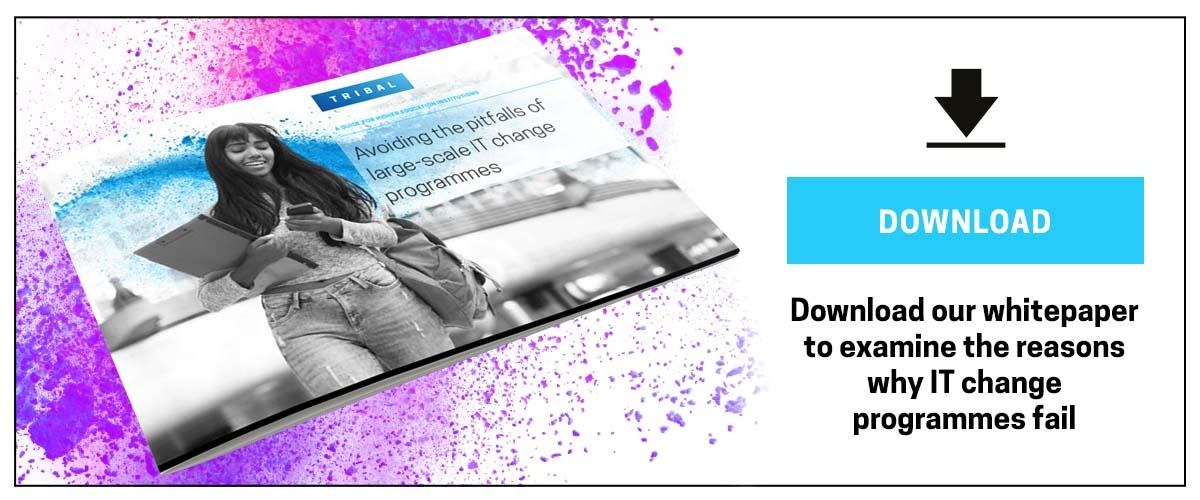Let’s be honest, few projects ever manage to deliver all the expected benefits or meet every stakeholders’ expectations. Implementing a new SMS is no small task, and inevitably scope changes, contingencies get spent, and there becomes a bucket of work that falls to the BAU team to be delivered under the ‘Continuous Improvement’ banner. And as time moves on there are new releases, new product modules, changing market drivers and expectations for student experience, new technology platforms and integrations that need to be kept on top of.
A few years down the track this can lead to a scenario described as ‘strategic drift’. Strategic drift occurs when an institution responds too slowly to changes in its external environment – which in the case of SMS deployment is technological change, and the operating models and business processes that supports that.
What is Strategic Drift?
Strategic drift represents the gap between what the market expects and what a business is delivering - and it gradually increases over time. Even in scenarios where there is a well-resourced and highly effective SMS team delivering continuous improvement, strategic drift can still occur when there is a step-change in the environment, such as the move to responsive web design or cloud-based platforms. At this point a change programme needs to be implemented to realign the strategic direction of the organisation with its external environment.
So where does that leave your institution? What do you have in place to ensure your ongoing technology investment is delivering what you need? And how do you realign it and get it back on track?
Minimising Strategic Drift - Continuous Improvement Contracts (CIC)
The best way to keep on top of this scenario is to enter into a CIC with your solution partner. CIC’s delivered by solution partners give institutions an external and holistic view of current and potential business performance. In many instances the same consultants that helped implement the solution can come back and conduct an optimisation review, giving consistency and continuity of service. As they are familiar with the original challenges and understand why certain design decisions were made, they will be able to easily identify where the greatest areas of unrealised project benefits are to be found. They also have specialist expertise your team can leverage and present existing relationships that you can build on.
How does a CIC work?
At Tribal, when we deliver a CIC we follow closely to our Aspire Implementation methodology, covering four key phases:
1. Vision and Strategy Planning
The initial engagement is to understand the new environment, what has caused the ‘drift’, and identify specific strategic HEI outcomes that the CIC needs to deliver. It is important at this stage that the institution shares the challenges they are facing and the vision of where they want the CIC to get them. Without this buy-in and strategic focus at the start of the project the optimisation review will be unable to identify opportunities that most closely align with what the institution is trying to achieve.
Of course, scope also needs to be agreed:
- Is the review going across the entire SMS lifecycle, or in a targeted area.
- If it is a targeted area, are there critical dependencies with other functions that mean both should be reviewed in unison? For example, automation in one area may not be possible without a change in business rules earlier in the process.
It is also imperative that the key stakeholders are identified at this stage to ensure there are no blockers or obstacles later in the project through lack of engagement.
2. Optimisation Review
The Optimisation Review combines the skills of Tribal’s Transformation and Change consultants and the technical expertise of Tribal’s product specialists. The review covers all key operating model elements (People, Process, Technology) to identify opportunities for improvement to inform the programme of change. During the review our consultants leverage many of the tools we discussed in our earlier blog - Beyond software: Bringing more to our customer implementations.
We will work with you to understand the most effective engagement approach across stakeholders and user groups, which is likely to be a combination of:
- Business/Technical maturity assessment
- Work-shadowing
- Interviews
- Workshops
This stage ends with a comprehensive report of all findings.
3. Solution Design
The Solution Design stage is about defining the CIC programme of work including scope, prioritising and phasing of optimisation opportunities, resource requirements, benefits realisation plan and any dependencies and constraints. Here we review the findings of the optimisation review and align them to the strategic priorities that have been set. There will also be a balancing act of delivering tactical projects to demonstrate some quick wins whilst setting up the broader strategic programme of change.
4. CIC Delivery
Once the CIC programme of work has been agreed we move into the delivery stage. Depending on resource availability and capability within the SMS support team, Tribal can help guide or deliver on elements of work. The agreed CIC will likely include:
- Medium to long term plan outlining how to achieve strategic objectives;
- Short-term plan providing smaller, but important, improvements that can be delivered to build momentum and engagement;
- Clearly budgeted solutions that add value and map to the benefits realisation plan; and when necessary
- Identification of organisational barriers that are prohibiting progress and hindering achievement of strategic objectives.
So how far have you drifted?
Do you think your institution may be suffering from strategic drift and you need to get back on track? Speak to us about how we can help. As your solution partner we are uniquely placed to help lead you through an optimisation review and then work with you to implement a programme of change and manage ongoing performance through a Continuous Improvement Contract.
TOPICS:
SHARE THIS ARTICLE:




